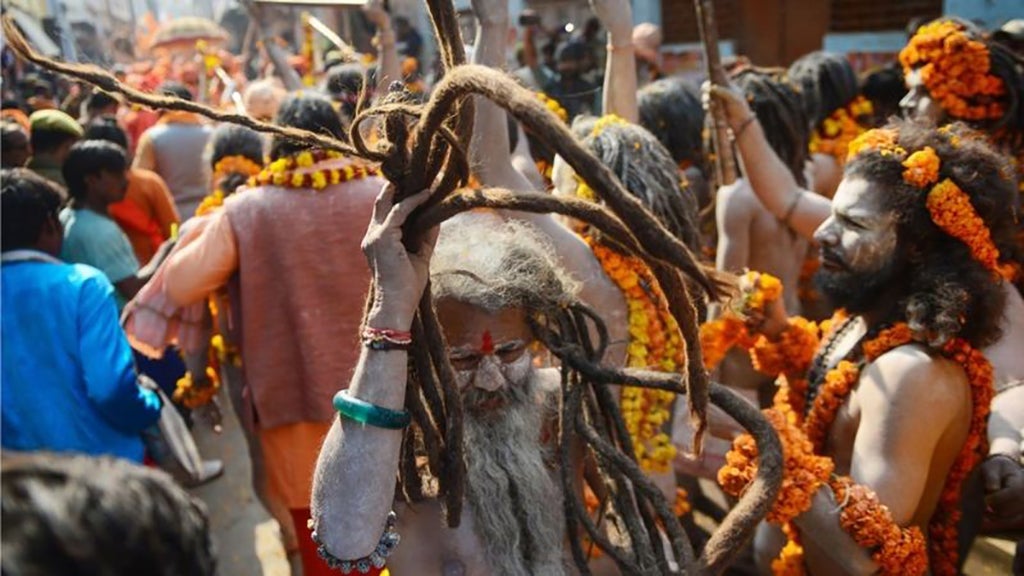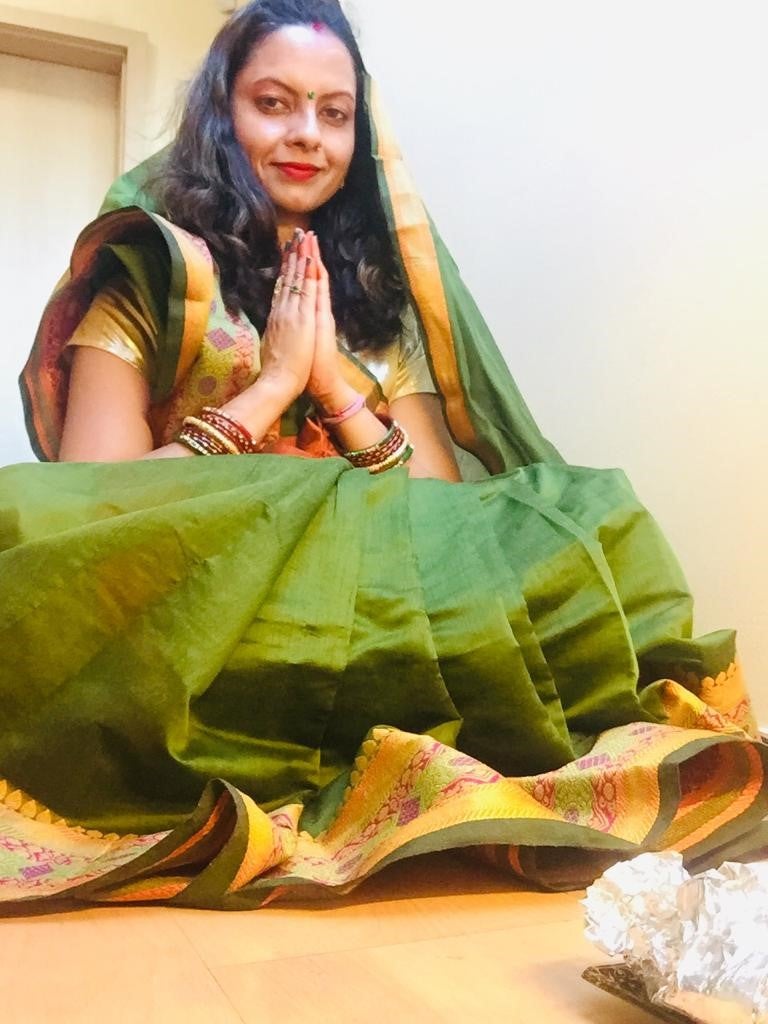Chants of Synchrony
contributed by Neha Khetrapal, 21 October 2020

Fig.1 Women engaging in ritual to please ‘Corona Mai’ in Dhanbad (photo credited to EPS, retrieved from The New Indian Express)
As women in North Indian states gather to worship and sing to please ‘Corona Mai’ (Coronavirus Goddess), onlookers might question the motivation to engage in effortful and ritualistic practices that do not involve immediate payoffs. These women are not alone in reverting to ‘socially scripted’ behaviors in the face of ecological threats, such as the presence of a virus. We have had numerous other examples in our history. One such instance includes the ‘Kilumi’ rain dance practiced by the traditional Akamba community of Kenya as a means of coping with unreliable rainfall.
As disparate as these examples sound, there is a common thread that brings them closer from different geographical areas and time points. Disease-causing pathogens or uncertain climatic conditions work in unpredictable ways, leaving people in psychologically anxious states. In search of solutions to cope with anxiety that arise from periods of uncertainty or to regain a lost sense of control, people turn to performing rituals as a proxy for addressing or mitigating danger in their surroundings.
Intricate Links between Rituals & Evolutionary History
Performed either in communal settings or in solitude, rituals could take on an array of forms. When performed with others in a group setting, the purpose of rituals is the identification of group members and facilitation of cooperation among them (Watson-Jones & Legare, 2016). During human evolution, living in groups has conferred a variety of advantages. On these lines, we have been biologically prepared to identify members of social groups to ensure our continuous survival. Although we have developed symbolic communication or language to express our cooperative intentions, such symbolic channels are susceptible to deception.
Collective rituals are a by-product of our evolutionary journey and serve as a vehicle for translating our symbolic commitment into ‘tangible’ overt acts that require us to put in energy, material resources and time (Lang, 2019). Why would people in North India join the rest of their social group members and risk stampede for bathing in the Ganges during ‘Kumbha Mela’?

Fig. 2 The Kumbha Mela festival in Allahabad (source: Getty Images, retrieved from BBC)
Group cohesion assumes importance when predatory risk or ecological stress is high and we need to tap into our extended network to ward off potential danger. People start using collective rituals to identify potential trustworthy reciprocators in their extended social networks over ‘free riders’. By engaging in rituals that involve no immediate “pay-off”, we send a strong signal to remain committed to our social groups despite the cost to the ‘self’ in terms of time and resources.
Synchrony
‘Interpersonal synchrony’ (i.e., group dancing, singing, chanting, and drumming) or moving and singing the same way at the same time are an integral part of collective rituals (Gelfand et al., 2020). By synchronizing our movements with those of the others in a group, we create a sense of ‘we’ that blurs the boundary between the self and the other. The fusion of our ‘personal’ and ‘social self’ promotes compassionate behaviors towards our in-group members. In other words, the resulting sense of connection that results from synchrony leaves lasting positive impacts on all co-participants even in the midst of ecological threats.
The sense of ensuing fusion has a limitation. A strong sense of identity fusion should be contrasted with group identification. Collective rituals, strengthened by synchronous performances, emerge in response to our collective attempts to regain our lost sense of control and to deal with our psychologically anxious states at an individual level. As long as people identify with their in-group members to improve their collective survival chances, the resulting group commitment is less likely to give way to extreme group behaviors such as self-sacrifice.
Two Undercurrents

Fig.3 This picture features Ms. Sapna Srivastava at her house in Budapest, right before beginning rituals to ward off misfortune on the auspicious occasion of ‘Ganesh Chaturthi’, a Hindu festival that is celebrated in India. This year women gathered in small numbers, as opposed to large gatherings to pray for health and prosperity. (Photo taken by the author, dated 22 August 2020)
Alongside the rituals to appease the Goddess, there were reports of people making music or singing from their balconies during the lockdown in an attempt to express solidarity with a larger anonymous community that is spread over a broader geographical area. Interpersonal synchrony pervades the emergence of these two ritual packages, viz. the music making and the chanting rituals. The underlying aim is to build social cohesion among identified group members, as a collective effort to channel resources, for mitigating danger and offer a collective solution to deal with psychologically anxious states.
What remains to be seen is whether the chanting rituals practiced by a small group of people in close physical proximity to please the Supreme power will evolve over time and give way to identify fusion, entailing extreme forms of sacrifice. On the other hand, the ‘balcony concerts’, requiring comparatively less time and effort, may have emerged as a means of identifying with a larger anonymous group of people who are separated from each other by considerable geographical distance. Time will unleash the growing or declining trajectory of both the ritual packages.
More questions

Fig. 4 Pictured above are idols of Lord Ganesha worshipped to mark the festival of ‘Ganesh Chaturthi’, the birth anniversary of Lord Ganesha who is the lord of wisdom, prosperity, knowledge and good fortune. The festival was celebrated with grandeur in September 2019 in Hungary by the local Hindu community of Budapest, back before the pandemic when gatherings were still allowed. (Photo taken by author)
With no doubt, the COVID-associated social and psychological threat has impacted our social and psychological being (see, Khetrapal & Agarwal, 2020). There are more interesting developments that await us in the distant or not-too distant future. Will we witness a new form of belief system that is divorced from the other established mainstream systems such as the Hindu, Jain, and the Buddhist religions? Will elaborate or unembellished collective rituals dominate this transformation? The answers will depend on the scarcity of resources that are available during the pandemic and the time course of viral domination.
Selected References
Gelfand, M. J., Caluori, N., Jackson, J. C., & Taylor, M. K. (2020). The cultural evolutionary trade-off of ritualistic synchrony. Philosophical Transactions of the Royal Society B, 375(1805), 20190432.
Khetrapal, N., & Agarwal, S. (2020). Social infrastructure: A viable opportunity for mitigating mental health crisis. Local Development & Society, 1-5.
Lang, M. (2019). The evolutionary paths to collective rituals: An interdisciplinary perspective on the origins and functions of the basic social act. Archive for the Psychology of Religion, 41(3), 224-252.
Watson-Jones, R. E., & Legare, C. H. (2016). The functions of ritual in social groups. Behavioral and Brain Sciences, 39, 40–41.
Neha Khetrapal earned her PhD (Linguistics) at Macquarie University (Australia) in 2016. She investigated syntactical abilities in children on the autism spectrum as a graduate student. Thereafter, she worked for the Agency for Science, Technology and Research (Singapore) before joining the Central European University in 2018 (Hungary) as a postdoctoral fellow. She will be joining the Jindal Institute of Behavioural Sciences at the O.P. Jindal Global University (India) as an Assistant Professor in 2021. Neha is enthusiastic about fostering collaborative research that bridges ‘typical’ and ‘atypical’ development. She is also broadly interested in understanding the role of culture in shaping our thought processes. She is inclined to believe that her interest in cross-cultural psychology emerged from her passion for travelling.
Disclaimer: The views and opinions expressed in this article are those of the authors and do not necessarily reflect the position of the blog editorial team or the Asia Research Institute.
South Asia | Southeast Asia | East Asia | Other Places | Hinduism | Buddhism | Islam | Christianity | Other Religions



